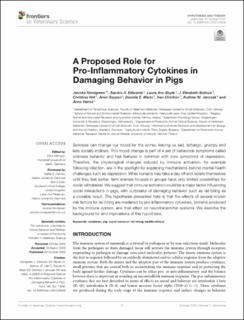| dc.contributor.author | Nordgreen, Janicke | |
| dc.contributor.author | Edwards, Sandra | |
| dc.contributor.author | Boyle, Laura A. | |
| dc.contributor.author | Bolhuis, Elizabeth | |
| dc.contributor.author | Veit, Christina Maria | |
| dc.contributor.author | Sayyari, Amin | |
| dc.contributor.author | Marin, Daniela E. | |
| dc.contributor.author | Dimitrov, Ivan | |
| dc.contributor.author | Janczak, Andrew M. | |
| dc.contributor.author | Valros, Anna | |
| dc.date.accessioned | 2020-11-06T10:48:00Z | |
| dc.date.available | 2020-11-06T10:48:00Z | |
| dc.date.created | 2020-10-07T15:12:48Z | |
| dc.date.issued | 2020 | |
| dc.identifier.citation | Frontiers in Veterinary Science. 2020, 7 . | en_US |
| dc.identifier.issn | 2297-1769 | |
| dc.identifier.uri | https://hdl.handle.net/11250/2686710 | |
| dc.description.abstract | Sickness can change our mood for the worse, leaving us sad, lethargic, grumpy and less socially inclined. This mood change is part of a set of behavioral symptoms called sickness behavior and has features in common with core symptoms of depression. Therefore, the physiological changes induced by immune activation, for example following infection, are in the spotlight for explaining mechanisms behind mental health challenges such as depression. While humans may take a day off and isolate themselves until they feel better, farm animals housed in groups have only limited possibilities for social withdrawal. We suggest that immune activation could be a major factor influencing social interactions in pigs, with outbreaks of damaging behavior such as tail biting as a possible result. The hypothesis presented here is that the effects of several known risk factors for tail biting are mediated by pro-inflammatory cytokines, proteins produced by the immune system, and their effect on neurotransmitter systems. We describe the background for and implications of this hypothesis. | en_US |
| dc.language.iso | eng | en_US |
| dc.rights | Attribution-NonCommercial-NoDerivatives 4.0 Internasjonal | * |
| dc.rights.uri | http://creativecommons.org/licenses/by-nc-nd/4.0/deed.no | * |
| dc.title | A Proposed Role for Pro-Inflammatory Cytokines in Damaging Behavior in Pigs | en_US |
| dc.type | Peer reviewed | en_US |
| dc.type | Journal article | en_US |
| dc.description.version | publishedVersion | en_US |
| dc.source.pagenumber | 15 | en_US |
| dc.source.volume | 7 | en_US |
| dc.source.journal | Frontiers in Veterinary Science | en_US |
| dc.identifier.doi | 10.3389/fvets.2020.00646 | |
| dc.identifier.cristin | 1837979 | |
| cristin.ispublished | true | |
| cristin.fulltext | original | |
| cristin.qualitycode | 1 | |

